Evaluating Animal Studies for Human Learning: Psychology
VerifiedAdded on 2021/02/19
|7
|1211
|22
Essay
AI Summary
This essay critically evaluates the usefulness of non-human animal studies for understanding learning in humans. It explores the historical contributions of animal studies, such as Pavlov's Classical Conditioning and the works of Skinner and Thorndike, highlighting their impact on understanding concepts like aversion and desensitization. The essay details the advantages of using animal models, including providing a touch of reality in experiments and avoiding potentially harmful procedures for humans. However, it also acknowledges the disadvantages, such as potential negative impacts on animal species and the limitations in directly extrapolating findings to humans due to differences in metabolic pathways and responses. The essay concludes by emphasizing the importance of considering both the benefits and drawbacks of animal studies in psychological research.

INVESTIGATING
PSYCHOLOGY
PSYCHOLOGY
Paraphrase This Document
Need a fresh take? Get an instant paraphrase of this document with our AI Paraphraser
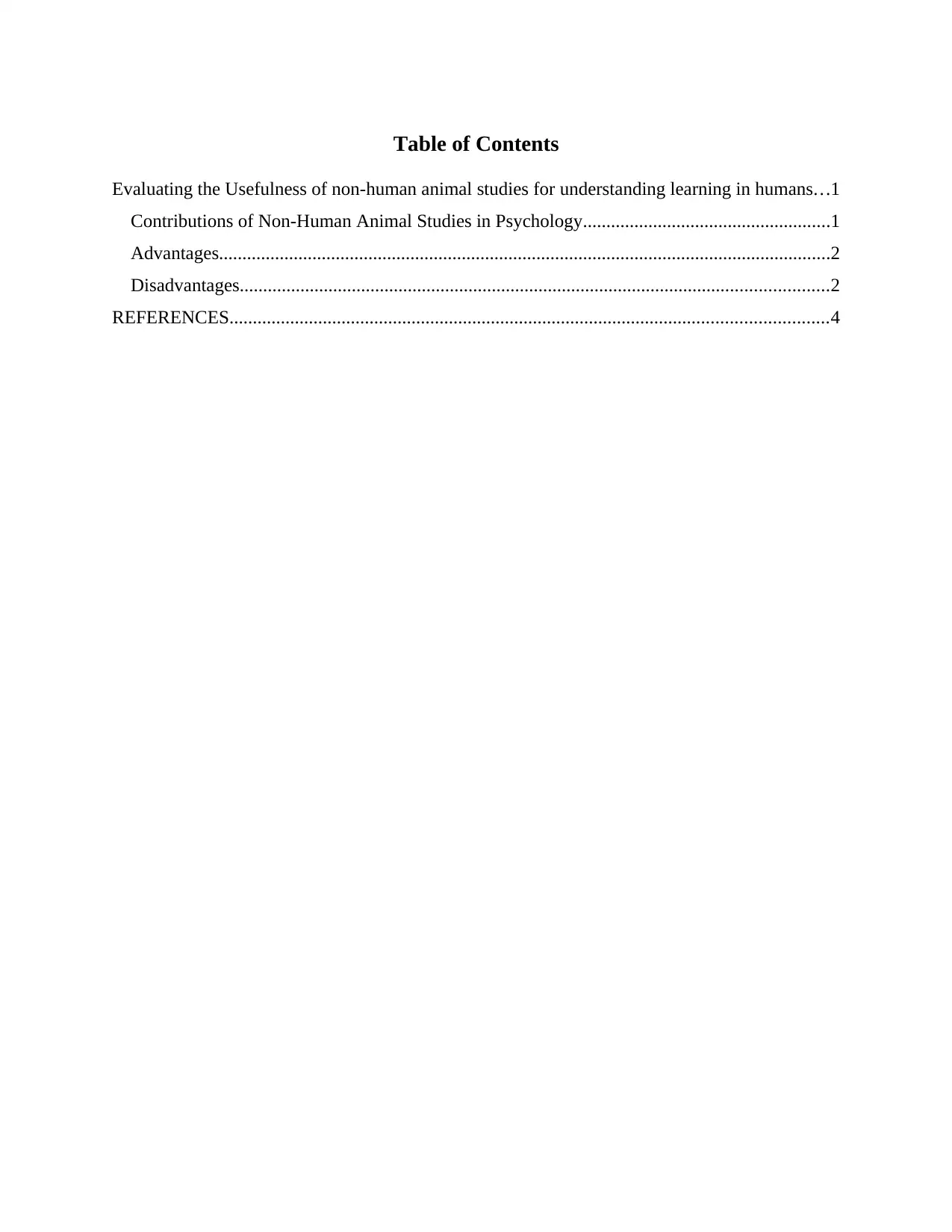
Table of Contents
Evaluating the Usefulness of non-human animal studies for understanding learning in humans...1
Contributions of Non-Human Animal Studies in Psychology.....................................................1
Advantages...................................................................................................................................2
Disadvantages..............................................................................................................................2
REFERENCES................................................................................................................................4
Evaluating the Usefulness of non-human animal studies for understanding learning in humans...1
Contributions of Non-Human Animal Studies in Psychology.....................................................1
Advantages...................................................................................................................................2
Disadvantages..............................................................................................................................2
REFERENCES................................................................................................................................4
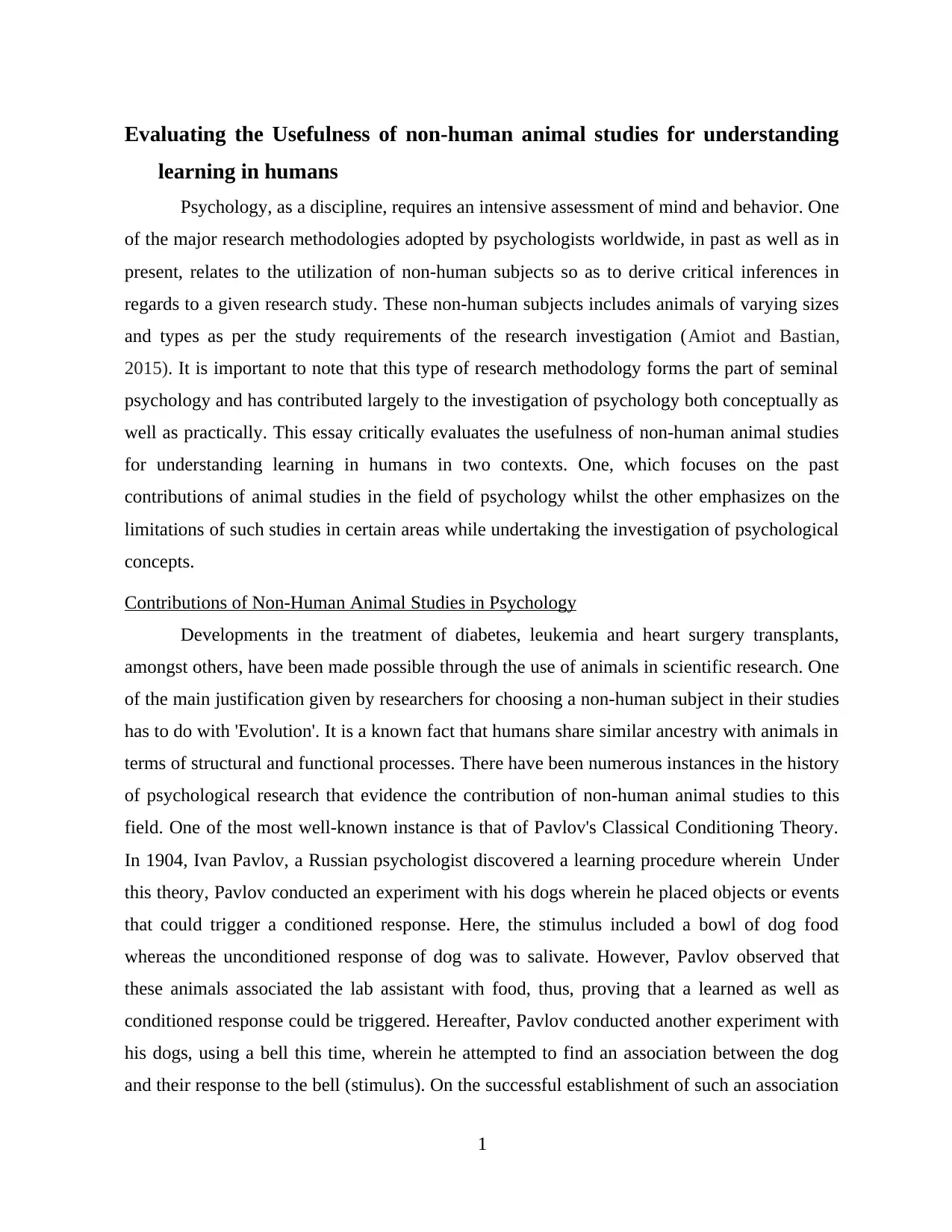
Evaluating the Usefulness of non-human animal studies for understanding
learning in humans
Psychology, as a discipline, requires an intensive assessment of mind and behavior. One
of the major research methodologies adopted by psychologists worldwide, in past as well as in
present, relates to the utilization of non-human subjects so as to derive critical inferences in
regards to a given research study. These non-human subjects includes animals of varying sizes
and types as per the study requirements of the research investigation (Amiot and Bastian,
2015). It is important to note that this type of research methodology forms the part of seminal
psychology and has contributed largely to the investigation of psychology both conceptually as
well as practically. This essay critically evaluates the usefulness of non-human animal studies
for understanding learning in humans in two contexts. One, which focuses on the past
contributions of animal studies in the field of psychology whilst the other emphasizes on the
limitations of such studies in certain areas while undertaking the investigation of psychological
concepts.
Contributions of Non-Human Animal Studies in Psychology
Developments in the treatment of diabetes, leukemia and heart surgery transplants,
amongst others, have been made possible through the use of animals in scientific research. One
of the main justification given by researchers for choosing a non-human subject in their studies
has to do with 'Evolution'. It is a known fact that humans share similar ancestry with animals in
terms of structural and functional processes. There have been numerous instances in the history
of psychological research that evidence the contribution of non-human animal studies to this
field. One of the most well-known instance is that of Pavlov's Classical Conditioning Theory.
In 1904, Ivan Pavlov, a Russian psychologist discovered a learning procedure wherein Under
this theory, Pavlov conducted an experiment with his dogs wherein he placed objects or events
that could trigger a conditioned response. Here, the stimulus included a bowl of dog food
whereas the unconditioned response of dog was to salivate. However, Pavlov observed that
these animals associated the lab assistant with food, thus, proving that a learned as well as
conditioned response could be triggered. Hereafter, Pavlov conducted another experiment with
his dogs, using a bell this time, wherein he attempted to find an association between the dog
and their response to the bell (stimulus). On the successful establishment of such an association
1
learning in humans
Psychology, as a discipline, requires an intensive assessment of mind and behavior. One
of the major research methodologies adopted by psychologists worldwide, in past as well as in
present, relates to the utilization of non-human subjects so as to derive critical inferences in
regards to a given research study. These non-human subjects includes animals of varying sizes
and types as per the study requirements of the research investigation (Amiot and Bastian,
2015). It is important to note that this type of research methodology forms the part of seminal
psychology and has contributed largely to the investigation of psychology both conceptually as
well as practically. This essay critically evaluates the usefulness of non-human animal studies
for understanding learning in humans in two contexts. One, which focuses on the past
contributions of animal studies in the field of psychology whilst the other emphasizes on the
limitations of such studies in certain areas while undertaking the investigation of psychological
concepts.
Contributions of Non-Human Animal Studies in Psychology
Developments in the treatment of diabetes, leukemia and heart surgery transplants,
amongst others, have been made possible through the use of animals in scientific research. One
of the main justification given by researchers for choosing a non-human subject in their studies
has to do with 'Evolution'. It is a known fact that humans share similar ancestry with animals in
terms of structural and functional processes. There have been numerous instances in the history
of psychological research that evidence the contribution of non-human animal studies to this
field. One of the most well-known instance is that of Pavlov's Classical Conditioning Theory.
In 1904, Ivan Pavlov, a Russian psychologist discovered a learning procedure wherein Under
this theory, Pavlov conducted an experiment with his dogs wherein he placed objects or events
that could trigger a conditioned response. Here, the stimulus included a bowl of dog food
whereas the unconditioned response of dog was to salivate. However, Pavlov observed that
these animals associated the lab assistant with food, thus, proving that a learned as well as
conditioned response could be triggered. Hereafter, Pavlov conducted another experiment with
his dogs, using a bell this time, wherein he attempted to find an association between the dog
and their response to the bell (stimulus). On the successful establishment of such an association
1
⊘ This is a preview!⊘
Do you want full access?
Subscribe today to unlock all pages.

Trusted by 1+ million students worldwide
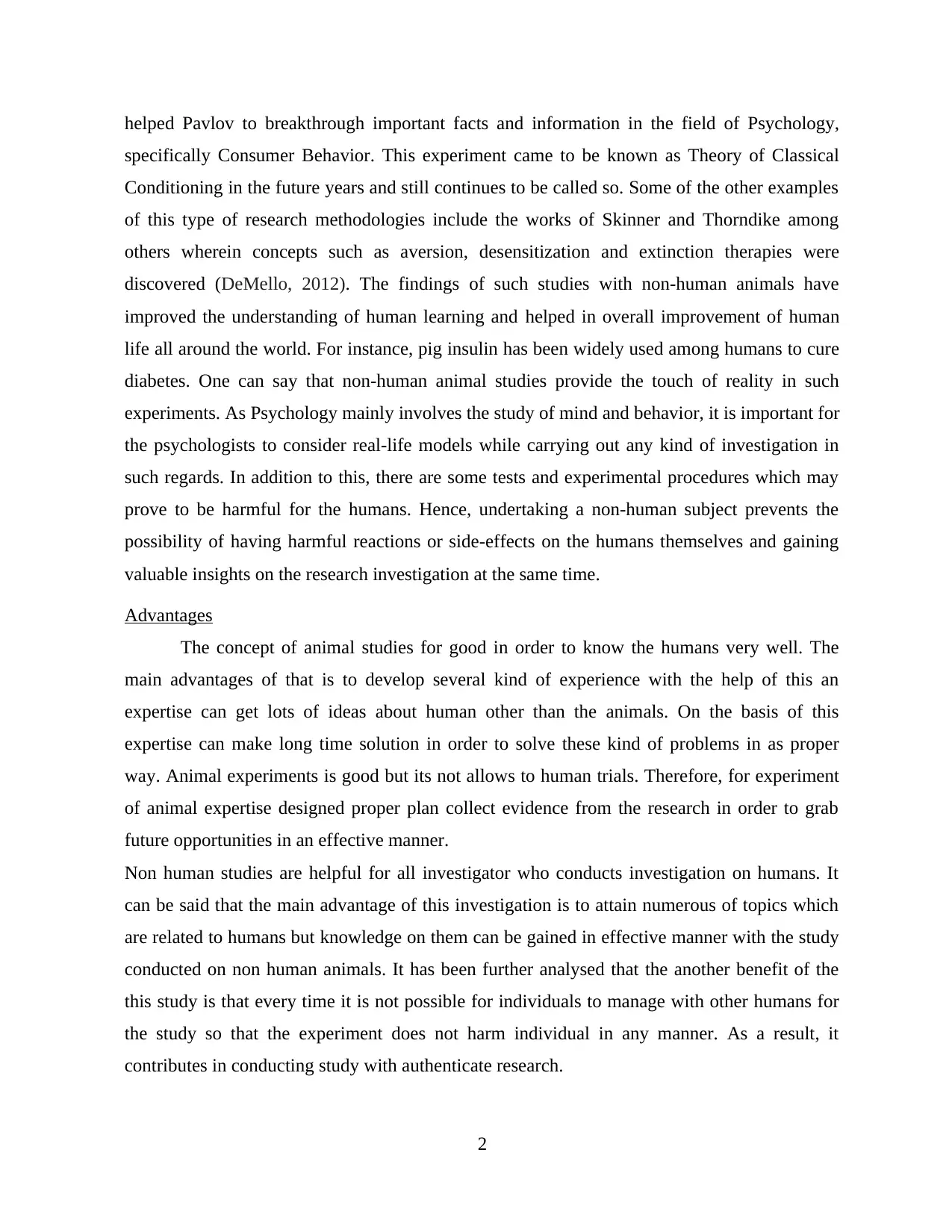
helped Pavlov to breakthrough important facts and information in the field of Psychology,
specifically Consumer Behavior. This experiment came to be known as Theory of Classical
Conditioning in the future years and still continues to be called so. Some of the other examples
of this type of research methodologies include the works of Skinner and Thorndike among
others wherein concepts such as aversion, desensitization and extinction therapies were
discovered (DeMello, 2012). The findings of such studies with non-human animals have
improved the understanding of human learning and helped in overall improvement of human
life all around the world. For instance, pig insulin has been widely used among humans to cure
diabetes. One can say that non-human animal studies provide the touch of reality in such
experiments. As Psychology mainly involves the study of mind and behavior, it is important for
the psychologists to consider real-life models while carrying out any kind of investigation in
such regards. In addition to this, there are some tests and experimental procedures which may
prove to be harmful for the humans. Hence, undertaking a non-human subject prevents the
possibility of having harmful reactions or side-effects on the humans themselves and gaining
valuable insights on the research investigation at the same time.
Advantages
The concept of animal studies for good in order to know the humans very well. The
main advantages of that is to develop several kind of experience with the help of this an
expertise can get lots of ideas about human other than the animals. On the basis of this
expertise can make long time solution in order to solve these kind of problems in as proper
way. Animal experiments is good but its not allows to human trials. Therefore, for experiment
of animal expertise designed proper plan collect evidence from the research in order to grab
future opportunities in an effective manner.
Non human studies are helpful for all investigator who conducts investigation on humans. It
can be said that the main advantage of this investigation is to attain numerous of topics which
are related to humans but knowledge on them can be gained in effective manner with the study
conducted on non human animals. It has been further analysed that the another benefit of the
this study is that every time it is not possible for individuals to manage with other humans for
the study so that the experiment does not harm individual in any manner. As a result, it
contributes in conducting study with authenticate research.
2
specifically Consumer Behavior. This experiment came to be known as Theory of Classical
Conditioning in the future years and still continues to be called so. Some of the other examples
of this type of research methodologies include the works of Skinner and Thorndike among
others wherein concepts such as aversion, desensitization and extinction therapies were
discovered (DeMello, 2012). The findings of such studies with non-human animals have
improved the understanding of human learning and helped in overall improvement of human
life all around the world. For instance, pig insulin has been widely used among humans to cure
diabetes. One can say that non-human animal studies provide the touch of reality in such
experiments. As Psychology mainly involves the study of mind and behavior, it is important for
the psychologists to consider real-life models while carrying out any kind of investigation in
such regards. In addition to this, there are some tests and experimental procedures which may
prove to be harmful for the humans. Hence, undertaking a non-human subject prevents the
possibility of having harmful reactions or side-effects on the humans themselves and gaining
valuable insights on the research investigation at the same time.
Advantages
The concept of animal studies for good in order to know the humans very well. The
main advantages of that is to develop several kind of experience with the help of this an
expertise can get lots of ideas about human other than the animals. On the basis of this
expertise can make long time solution in order to solve these kind of problems in as proper
way. Animal experiments is good but its not allows to human trials. Therefore, for experiment
of animal expertise designed proper plan collect evidence from the research in order to grab
future opportunities in an effective manner.
Non human studies are helpful for all investigator who conducts investigation on humans. It
can be said that the main advantage of this investigation is to attain numerous of topics which
are related to humans but knowledge on them can be gained in effective manner with the study
conducted on non human animals. It has been further analysed that the another benefit of the
this study is that every time it is not possible for individuals to manage with other humans for
the study so that the experiment does not harm individual in any manner. As a result, it
contributes in conducting study with authenticate research.
2
Paraphrase This Document
Need a fresh take? Get an instant paraphrase of this document with our AI Paraphraser
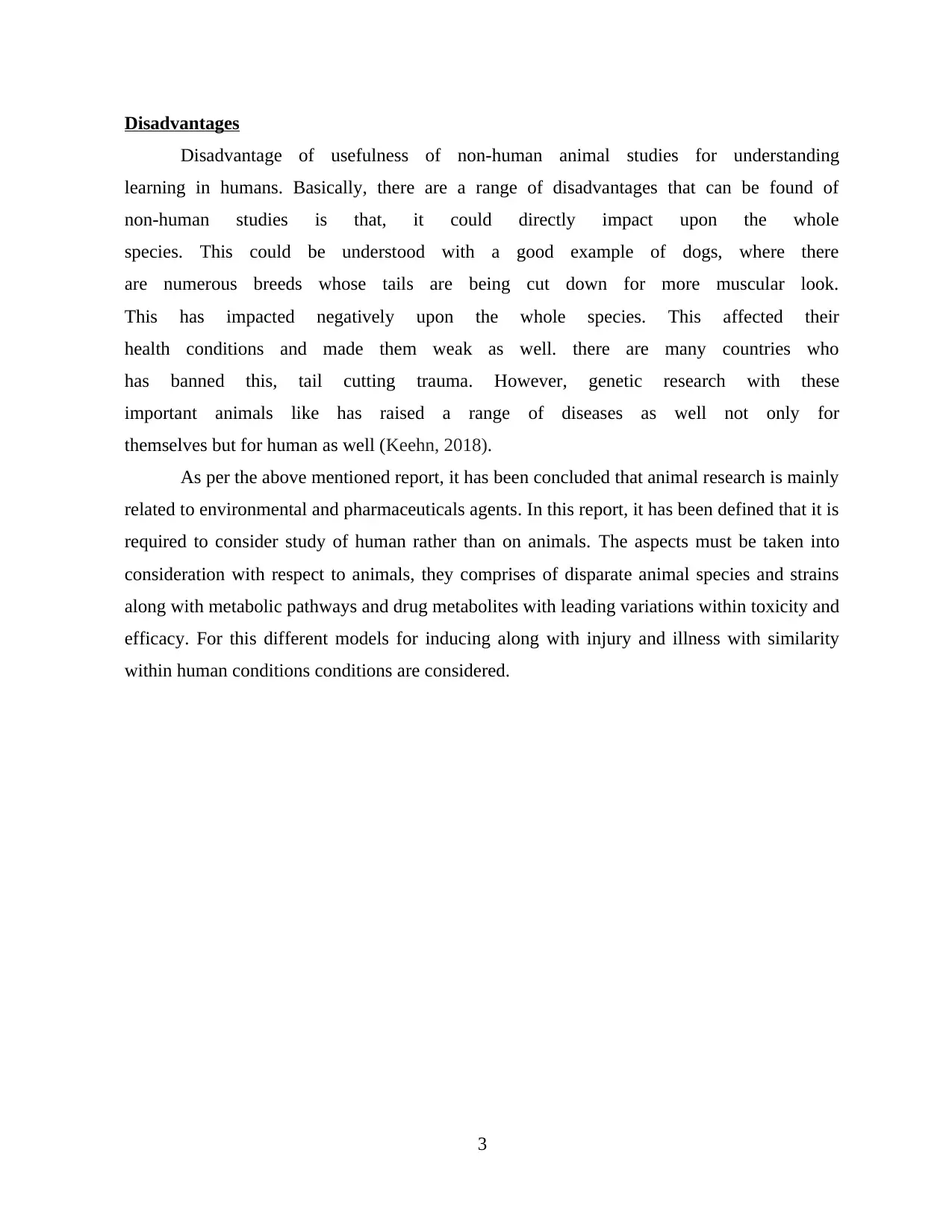
Disadvantages
Disadvantage of usefulness of non-human animal studies for understanding
learning in humans. Basically, there are a range of disadvantages that can be found of
non-human studies is that, it could directly impact upon the whole
species. This could be understood with a good example of dogs, where there
are numerous breeds whose tails are being cut down for more muscular look.
This has impacted negatively upon the whole species. This affected their
health conditions and made them weak as well. there are many countries who
has banned this, tail cutting trauma. However, genetic research with these
important animals like has raised a range of diseases as well not only for
themselves but for human as well (Keehn, 2018).
As per the above mentioned report, it has been concluded that animal research is mainly
related to environmental and pharmaceuticals agents. In this report, it has been defined that it is
required to consider study of human rather than on animals. The aspects must be taken into
consideration with respect to animals, they comprises of disparate animal species and strains
along with metabolic pathways and drug metabolites with leading variations within toxicity and
efficacy. For this different models for inducing along with injury and illness with similarity
within human conditions conditions are considered.
3
Disadvantage of usefulness of non-human animal studies for understanding
learning in humans. Basically, there are a range of disadvantages that can be found of
non-human studies is that, it could directly impact upon the whole
species. This could be understood with a good example of dogs, where there
are numerous breeds whose tails are being cut down for more muscular look.
This has impacted negatively upon the whole species. This affected their
health conditions and made them weak as well. there are many countries who
has banned this, tail cutting trauma. However, genetic research with these
important animals like has raised a range of diseases as well not only for
themselves but for human as well (Keehn, 2018).
As per the above mentioned report, it has been concluded that animal research is mainly
related to environmental and pharmaceuticals agents. In this report, it has been defined that it is
required to consider study of human rather than on animals. The aspects must be taken into
consideration with respect to animals, they comprises of disparate animal species and strains
along with metabolic pathways and drug metabolites with leading variations within toxicity and
efficacy. For this different models for inducing along with injury and illness with similarity
within human conditions conditions are considered.
3
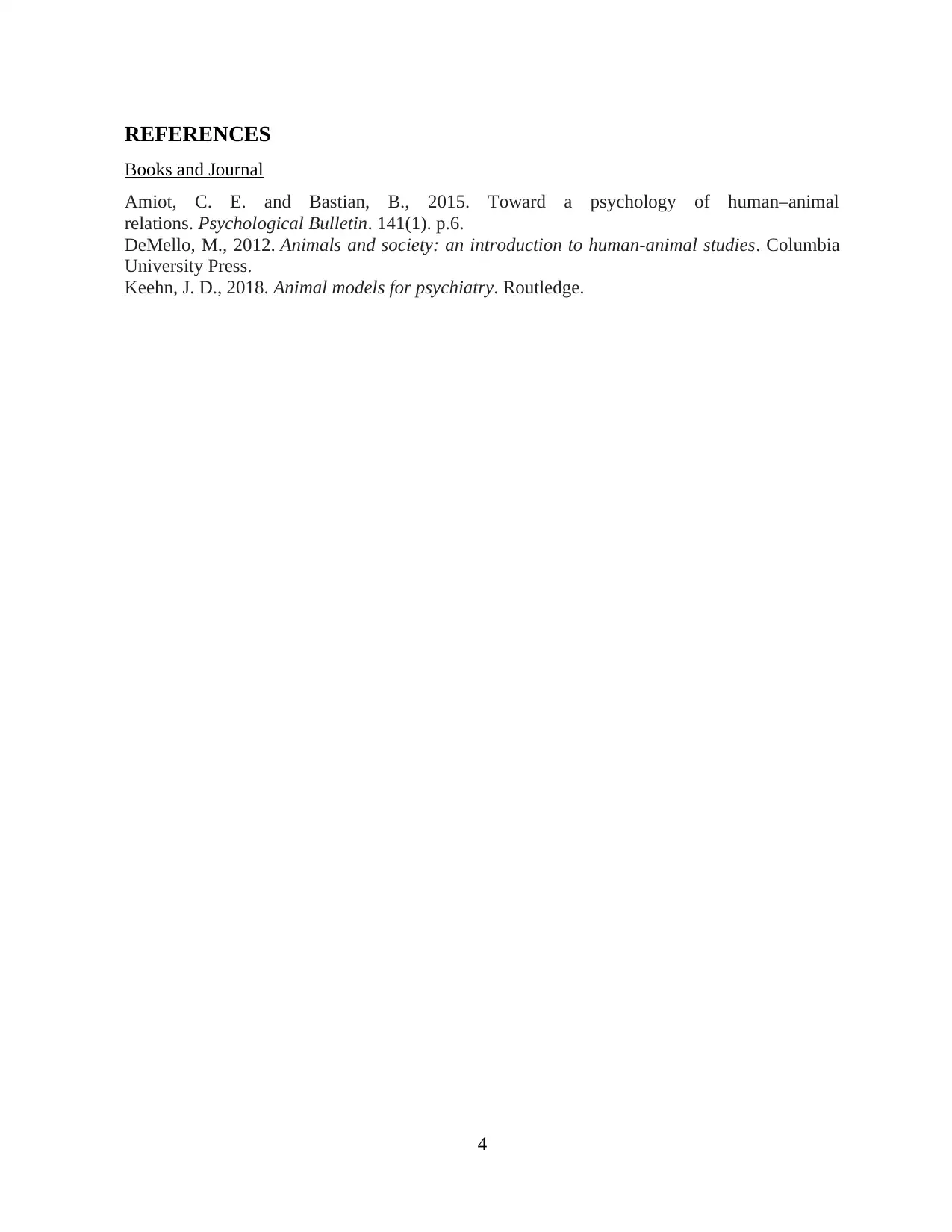
REFERENCES
Books and Journal
Amiot, C. E. and Bastian, B., 2015. Toward a psychology of human–animal
relations. Psychological Bulletin. 141(1). p.6.
DeMello, M., 2012. Animals and society: an introduction to human-animal studies. Columbia
University Press.
Keehn, J. D., 2018. Animal models for psychiatry. Routledge.
4
Books and Journal
Amiot, C. E. and Bastian, B., 2015. Toward a psychology of human–animal
relations. Psychological Bulletin. 141(1). p.6.
DeMello, M., 2012. Animals and society: an introduction to human-animal studies. Columbia
University Press.
Keehn, J. D., 2018. Animal models for psychiatry. Routledge.
4
⊘ This is a preview!⊘
Do you want full access?
Subscribe today to unlock all pages.

Trusted by 1+ million students worldwide

5
1 out of 7
Related Documents
Your All-in-One AI-Powered Toolkit for Academic Success.
+13062052269
info@desklib.com
Available 24*7 on WhatsApp / Email
![[object Object]](/_next/static/media/star-bottom.7253800d.svg)
Unlock your academic potential
Copyright © 2020–2025 A2Z Services. All Rights Reserved. Developed and managed by ZUCOL.





